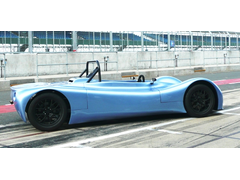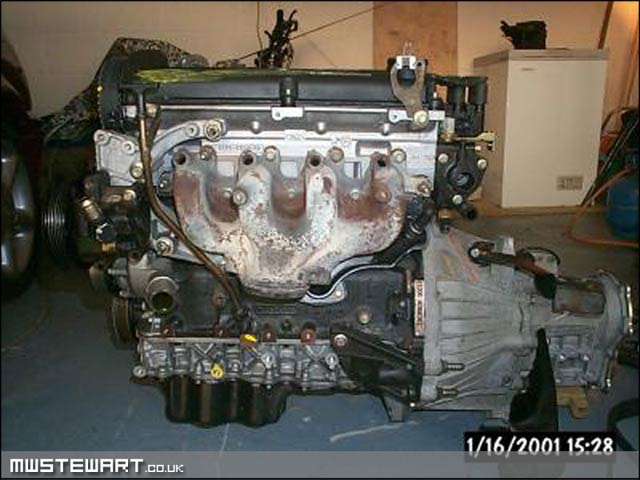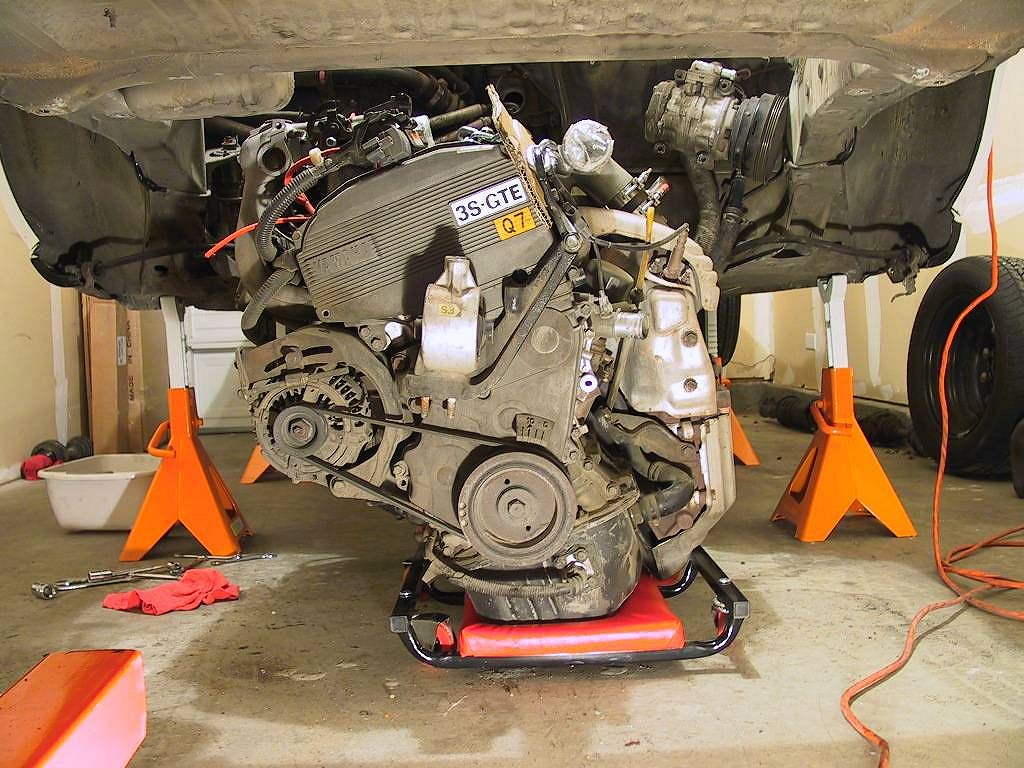'twas the Mini (proper one) that had the box under the engine

ATB
Simon

Since years ago, it's become very a common approach to take a transverse engine + transmission as found in most FWD cars and use it to build all
sorts of middle engined cars: Riot, Atom, Elise, MR2 and so on.
The one thing I don't like about this, compared to other arrangements like say the Locost, is that I get the impression that the engine ends up
sitting a lot higher because the transmission sits kind of underneath.
Then there are middle engined cars using other approaches, such as chain driven bike engined cars, BECs using a special transmission like the Radical
SR3 and cars using a longitudinally mounted engine coupled to a transaxle.
I know many examples of chain driven bike engined cars, I think they are ok but they can handle little torque. If you make them handle good torque and
your tyres have good grip, you need to readjust and retension the chain all the time. The chain is most typically the weakest link in terms of
reliability.
I know few cars using transaxles and they are all expensive. You have big V8 Ultimas, tiny Retogas using Elite Racing Transmission boxes, Norma Le
Mans type things where the gear box is a fully stressed member and so on.
The summmary would then be:
-Go classic front-middle engined
-Have the engine sitting high-ish
-Go chain driven which is unreliable
-Spend big on whatever transaxle thing
-Spend big on an SR3-like BEC solution
Comments and opinions, please? What options am I missing? What do other cars use, like say Nobles or whatever else out there? Why not couple whatever
2 liter 4 cylinder engine to a cheap transaxle like those classic Renault ones? What's the reason why nobody seems to be going that route? On the
high engine option, would it be possible to like tilt the power train, i.e. make the cylinder heads point more towards the occupants in order to make
it sit lower, maybe using a dry sump system? Would that help?
Enough thinking for the day, off to bed...
quote:
Originally posted by Alez... Why not couple whatever 2 liter 4 cylinder engine to a cheap transaxle like those classic Renault ones? What's the reason why nobody seems to be going that route? On the high engine option, would it be possible to like tilt the power train, i.e. make the cylinder heads point more towards the occupants in order to make it sit lower, maybe using a dry sump system? Would that help?...
I have/had the same dilemma, Iíd also add that going the midi route with a regular fwd engine/box also makes the car rear heavy as the engine sits
right over the rear axle line, more rear-engined than mid-engined
In an ideal world Iíd have gone light high reving car engine on a ďproperĒ transaxle but canít justify the cost of a racing transaxle. On a side note
these seem ridiculously priced even second hand for ones regarded as unreliable and fragile!
I did consider Audi or Subaru units but these produce a lot off rear overhang, arenít light etc.
One ingenious solution Iíve seen was on a car called the Onyx Mongoose, now unavailable, although I believe the company is still trading. Bassicly
they took a regular fwd engine box and inserted an adaptor plate to allow the engine to be rotated forward, in relation to the gearbow, doing this had
two benefits; it lowered the centre of gravity and additionally moved its mass forward.
So my conclusions were as follows: if I was making a big engined car GT40 replica etc. Iíd have used an Audi or Reanault Transaxle, for a small light
vehicle Iíd go proper new transaxle, on a sensible budget (my decision) go chain drive and bike engine
[Edited on 18/12/11 by orton1966]
[Edited on 18/12/11 by orton1966]
I wouldn't say my front middy volvo 850 engine/gearbox combo is any higher than it would be if it were mounted north south as in a seven.
My sump sits about 2-3" below the chassis rails iirc
The advantage of using a transverse engine and subframe, is that you can get the engine, transmission and drive train all in one package, and just build the rest of the frame around it. Mine is mid engined using a transaxle and is plenty low enough, with the sump about 15mm below the chassis.
Not Locost, but it does show what you can do to a fwd transverse donor.
Race kits Falcon
I think you'll find most fwd engine/box combo's have the box of to the side with the output for the driveshafts rearwards!
'twas the Mini (proper one) that had the box under the engine
ATB
Simon
Are you familiar with this car?

I believe it uses a duratec and associated FWD gearbox, but then drives each rear wheel from chain. So, 2 chains and half the torque on each, and a
bit more freedom on orientation of things (I guess).
To my mind it is about the prettiest home-built car I have ever seen. (Lotus c23 perhaps excepting).

The lotus c23 also does a decent job of keeping height down (duratec engine, audi transaxle, clever adapter).
more details of eclipse in this thread. http://www.locostbuilders.co.uk/viewthread.php?tid=155961
Transverse FWD engines sit no higher or lower than a longitudinal RWD. The gearbox sits on the end on all modern engines not underneath.
I can only think it's either the mini with it's gearbox in the sump thatmakes people think they're all like that, or the fact that
almost all modern OHC engines are higher than the old engines in RWD's.
Here's a picture of a Zetec on an iB5 gearbox. As you can see it's above the bottom of the sump, which in itself is pretty shallow compared
with some.

[Edited on 18/12/11 by iank]
quote:
Originally posted by iank
Transverse FWD engines sit no higher or lower than a longitudinal RWD. The gearbox sits on the end on all modern engines not underneath....
quote:
Originally posted by kb58Really, lowering the engine further simply isn't a hard requirement for amatuer-built cars. Sure, if you're in a hardcore race series it's a big deal, but typical builders aren't. Summed up, there's no practical reason to bother. Using a dead-stock FWD drivetrain mounted mid-engine in a car that weighs less than half the original gives plenty of performance for most people.
quote:
Originally posted by orton1966In an ideal world Iíd have gone light high reving car engine on a "proper" transaxle but canít justify the cost of a racing transaxle.
quote:
Originally posted by orton1966One ingenious solution Iíve seen was on a car called the Onyx Mongoose, now unavailable, although I believe the company is still trading. Bassicly they took a regular fwd engine box and inserted an adaptor plate to allow the engine to be rotated forward, in relation to the gearbow, doing this had two benefits; it lowered the centre of gravity and additionally moved its mass forward.
quote:
Originally posted by SimonI think you'll find most fwd engine/box combo's have the box of to the side with the output for the driveshafts rearwards!
quote:
Originally posted by matt_gsxr
Are you familiar with this car?
I believe it uses a duratec and associated FWD gearbox, but then drives each rear wheel from chain. So, 2 chains and half the torque on each, and a bit more freedom on orientation of things (I guess).
To my mind it is about the prettiest home-built car I have ever seen. (Lotus c23 perhaps excepting).
The lotus c23 also does a decent job of keeping height down (duratec engine, audi transaxle, clever adapter).
quote:
Originally posted by iankTransverse FWD engines sit no higher or lower than a longitudinal RWD. The gearbox sits on the end on all modern engines not underneath.
I can only think it's either the mini with it's gearbox in the sump thatmakes people think they're all like that, or the fact that almost all modern OHC engines are higher than the old engines in RWD's.
Here's a picture of a Zetec on an iB5 gearbox. As you can see it's above the bottom of the sump, which in itself is pretty shallow compared with some.
quote:
Originally posted by kb58^This. As was said, the bottom of the flywheel is what dictates overall height of the assembly, and a FWD lump is no higher than it's front-engine/rear-drive counterpart.
The Honda K24 I used is virtually the same height whether used at the rear of the car or the front, 4" under the pan/bellhousing.
quote:
Originally posted by orton1966Iíd also add that going the midi route with a regular fwd engine/box also makes the car rear heavy as the engine sits right over the rear axle line, more rear-engined than mid-engined
quote:
Originally posted by matt_gsxrThe lotus c23 also does a decent job of keeping height down (duratec engine, audi transaxle, clever adapter).
Indeed most FWD arrangements have the box to the side and the outputs to the rear, allowing the engine to be leaned backward or forward if needed, but
technically there's no reason at all for it to be higher than any other configuration. The only configuration that might NEED to be higher is a
front engined 4wd using solid axles or a front diff, due to the underneath arrangement of the front axle. Even 4WD front engined audis have the engine
pretty damn low by shoving it forward and putting the diff part way up the back of the bellhousing.
MR2 turbo engine:

Pug Mi16 engine (i think)

[Edited on 18/12/11 by coyoteboy]
Just to add to the chorus pointing out that most modern transverse FWD drivetrains have the gearbox end-on to the engine and the axle line not that
far below the crankshaft centreline, here's photos of my original Corolla Silvertop drivetrain and the Mitsubishi Lancer 4G69 package I'm
using now.
FWD Corolla drivetrain
I am using a zetec and standard box from a mondeo. The engine is tilted forwards 12 degrees in the standard car. I intend to use the engine tilted
forwards to 22 degrees, (extra baffles in the sump to stop the oil surge on braking - I saw the onyx and that was their major problem) you end up with
the 12cm of ground clearance and drive shafts parallel to the ground when using 195/50/15 wheels and tyres. This gives a height to the top of the
engine of 64 cm (with the 12cm ground clearance). The centre of mass of the engine and box is 24-25cm in front of the drive shaft centre line when
installed this way). You can see the mock up in my avatar/gallery.
Regards
Hugh
Another thing to note is how nicely a FWD assembly installs into the rear of a car. Doesn't require the car to get abnormally long, and it's one reason why I used one on my Sevenesque car, Midlana. However, I do agree that even though the engine is ahead of the rear axle centerline, it does result in a sizable rear weight bias. I haven't checked mine recently but it's somewhere between 60-70% rear weight-biased. Depending upon driving style, it's either no issue, really fast, or scary.